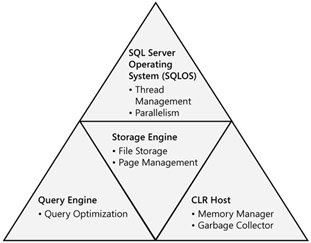Appendix B: SQL Server 2005 Architecture and Internals
Overview
To become a true IT professional-level database developer, candidates need to know more than just the basics about the product with which they are working. SQL Server is no exception to this rule, and given how it's grown into a full-fledged application server, there are a number of internals topics that are relevant to a successful database developer and that aren't covered in today's training materials or instructor-led classes due to the amount of time and depth required to cover them properly. See Figure B-1 for a look at the internals topics covered in this index.

Figure B-1: SQL Server internal components covered by this appendix
This appendix will cover many of the internals topics that could not be covered in-depth in the chapters of the book. It is important to note that much of the detail contained within this appendix is in-depth. While the exams themselves do not necessarily test to the level of detail contained here, the information is highly relevant; knowledge in these areas can make the difference between a passing grade on the exam and mastery of SQL Server development.
Topics covered in this appendix are as follows. Mastery of each of these topics can help solidify a database developer's understanding of SQL Server 2005, and therefore increase his or her chances of doing well on the certification exam.
-
Hardware Trends and Their Effect on SQL Server 2005 Hardware manufacturers are constantly looking for new ways to improve system performance. SQL Server 2005 takes advantage of many of these new trends; developers must be aware of what is happening behind the scenes.
-
SQL Operating System (SQLOS) SQLOS is the layer between the operating system and SQL Server itself. SQLOS is new in SQL Server 2005. Developers who understand how SQLOS operates are much more successful in writing solid, high-performing code.
-
Common Language Runtime (CLR) Host The CLR host is what enables developers to write .NET code such as C# .NET and Visual Basic .NET, and integrate that code seam-lessly with SQL Server. Understanding the strengths and weaknesses of the CLR host is very important when designing code objects that utilize .NET code within SQL Server.
-
SQL Server 2005 Storage Engine The storage engine is the heart of the database server. The storage engine is responsible for physically storing and retrieving information in the most efficient manner. Every developer should understand his or her database's physical structure.
-
SQL Server 2005 Query Engine The query engine is responsible for moving data between the storage engine and the user. The query engine is composed of several parts, and database developers must have an understanding of each of these parts if they are going to write efficient, scalable code.
-
SQL Server 2005 Index Internals Indexes are used to assist both the query and storage engines to construct efficient queries and return data in the most efficient manner. Developing good indexing strategies is an important part of any database developer's workload.
New index types in SQL Server 2005 include enhanced full-text indexes and indexes on XML data types. It is essential for developers to understand exactly how these new index types function.
-
Database Encryption SQL Server 2005 provides a host of new features related to security and encryption. A good understanding of these technologies and their usage is vital.
EAN: N/A
Pages: 162